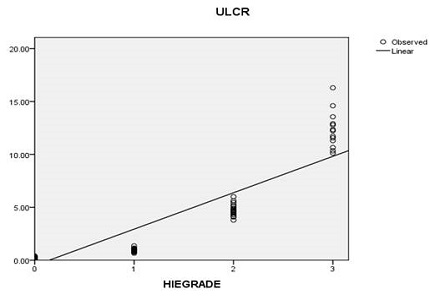Urinary lactate to creatinine ratio in neonates with perinatal asphyxia and its correlation with severity of hypoxic ischemic encephalopathy
Abstract
Background: Neonates with perinatal asphyxia are prone to development of hypoxic ischemic-encephalopahty (HIE). There are no reliable methods for prediction of HIE in these neonates.
Objectives: To determine urinary lactate to creatinine ratio in neonates with perinatal asphyxia and its correlation with severity of hypoxic ischemic encephalopathy.
Material and Methods: A prospective study was carried out at neonatal intensive care unit (NICU) at Department of Pediatrics, MLB Medical College Jhansi. 50 neonates born at > 36 weeks gestation with perinatal asphyxia, admitted in neonatal intensive care unit were taken as cases and 50 normal newborns with gestational age > 36 week included as control. We measured the ratio of lactate to creatinine in urine sample by colometric technique within 24 hr after birth both in cases and controls. All newborns were followed for 7 days during their stay in hospital for development of HIE. The results were correlated with the subsequent presence or absence of HIE.
Results: The study revealed that mean urinary lactate to creatinine ratio during first 24 hours of life was higher in asphyxiated neonates than control group(5.35±4.59 vs 0.18±.07), the difference was found to be statistically highly significant (z=7.693; p=<0.0001). The grade of HIE correlated with the greater urinary lactate to creatinine ratio among cases and was significant (p=<0.0001).
Conclusion: The urinary lactate to creatinine (Urinary L/C) ratio in newborn infants with asphyxia is significantly increased early in course of the disease which can be used as useful parameter for predicting the development of hypoxic ischemic encephalopathy.
Downloads
References
2. Perlman JM, Risser R. Can asphyxiated infants at risk for neonatal seizures be rapidly identified by current high-risk markers? Pediatrics. 1996 Apr;97(4):456-62. [PubMed]
3. Volpe JJ, editor. Neurology of the Newborn. 5th ed. Philadelphia: Elsevier Science; 2008. Hypoxic‐Ischemic Encephalopathy: Biochemical and Physiological Aspects; pp.221‐372.
4. Zanardo V, Demi M, Padovani E. [Hypoxic-ischemic brain damage in the newborn] Pediatr Med Chir. 1997 Jan-Feb;19(1):1-2. [PubMed]
5. Martínez-Pérez B, de la Torre-Díez I, López-Coronado M. Mobile health applications for the most prevalent conditions by the World Health Organization: review and analysis. J Med Internet Res. 2013 Jun 14;15(6):e120. doi: 10.2196/jmir.2600. [PubMed]
6. Vannucci RC, Perlman JM. Interventions for perinatal hypoxic-ischemic encephalopathy. Pediatrics. 1997 Dec;100(6):1004-14. [PubMed]
7. Johnston MV. Selective vulnerability in the neonatal brain. Ann Neurol. 1998 Aug;44(2):155-6. [PubMed]
8. Thornberg E, Thiringer K, Hagberg H, Kjellmer I. Neuron specific enolase in asphyxiated newborns: association with encephalopathy and cerebral function monitor trace. Arch Dis Child Fetal Neonatal Ed. 1995 Jan;72(1):F39-42.
9. Martín-Ancel A, García-Alix A, Pascual-Salcedo D, Cabañas F, Valcarce M, Quero J. Interleukin-6 in the cerebrospinal fluid after perinatal asphyxia is related to early and late neurological manifestations. Pediatrics. 1997 Nov;100(5):789-94.
10. Huang CC, Wang ST, Chang YC, Lin KP, Wu PL. Measurement of the urinary lactate:creatinine ratio for the early identification of newborn infants at risk for hypoxic-ischemic encephalopathy. N Engl J Med. 1999 Jul 29;341(5):328-35.
11. Perlman JM, Tack ED. Renal injury in the asphyxiated newborn infant: relationship to neurologic outcome. J Pediatr. 1988 Nov;113(5):875-9. [PubMed]
12. da Silva S, Hennebert N, Denis R, Wayenberg JL. Clinical value of a single postnatal lactate measurement after intrapartum asphyxia. Acta Paediatr. 2000 Mar;89(3):320-3.
13. Leth H, Toft PB, Peitersen B, Lou HC, Henriksen O. Use of brain lactate levels to predict outcome after perinatal asphyxia. Acta Paediatr. 1996 Jul;85(7):859-64. [PubMed]
14.Nordström L, Chua S, Roy A, Naka K, Persson B, Arulkumaran S. Lactate, lactate/pyruvate ratio and catecholamine interrelations in cord blood at delivery in complicated pregnancies. Early Hum Dev. 1998 Aug 28;52(1):87-94.
15. Hanrahan JD, Cox IJ, Edwards AD, Cowan FM, Sargentoni J, Bell JD, Bryant DJ, Rutherford MA, Azzopardi D. Persistent increases in cerebral lactate concentration after birth asphyxia. Pediatr Res. 1998 Sep;44(3):304-11.
16. Bellomo R. Bench-to-bedside review: lactate and the kidney. Crit Care. 2002 Aug;6(4):322-6. Epub 2002 Jun 7.
17. Poole RC, Halestrap AP. Transport of lactate and other monocarboxylates across mammalian plasma membranes. Am J Physiol. 1993 Apr;264(4 Pt 1):C761-82. [PubMed]
18. Ikeda T, Murata Y, Quilligan EJ, Parer JT, Murayama T, Koono M: Histologic and biochemical study of the brain, heart, kidney, and liver in asphyxia caused by occlusion of the umbilical cord in near-term fetal lambs.Am J Obstet Gynecol 2000, 182(2):449-57. [PubMed]
19. Sarnat HB, Sarnat MS. Neonatal encephalopathy following fetal distress. A clinical and electroencephalographic study. Arch Neurol. 1976 Oct;33(10):696-705.
20. Zuppi C, Messana I, Forni F, Rossi C, Pennacchietti L, Ferrari F, Giardina B. 1H NMR spectra of normal urines: reference ranges of the major metabolites. Clin Chim Acta. 1997 Sep 8;265(1):85-97. [PubMed]
21. Ghotbi N, Najibi B. Measurement of the urinary lactate/creatinine ratio for early diagnosis of the hypoxic-ischemic encephalopathy in newborns. Iran J Pediatr. 2010 Mar;20(1):35-40.
22. Ojha RK, Singh SK, Batra S, Sreenivas V, Puliyel JM. Lactate: creatinine ratio in babies with thin meconium staining of amniotic fluid. BMC Pediatr. 2006 Apr 20;6:13.

Copyright (c) 2016 Author (s). Published by Siddharth Health Research and Social Welfare Society

This work is licensed under a Creative Commons Attribution 4.0 International License.


 OAI - Open Archives Initiative
OAI - Open Archives Initiative


